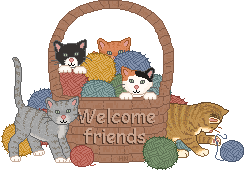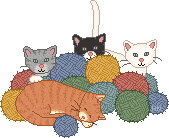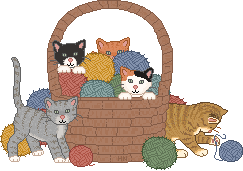Please Note this is only for advice and help
never risk your cats health also consult your
own vet before giving any kind of treatment
Thank You



Care of the old cat
Modern veterinary medicine has added years
to your cat's life-span. With reasonably good
care, it may live to 15 or even 19 years old
In fact today it is not unusual to see cats that
are at least 20 years of age.
At what age is a cat old? most vets agree that chronological age is not
as important as the
degree and effect of ageing.
These are related to many factors, among
them the loss of tissue vitality and
organic failure.
THE AGEING PROCESS
The rate of ageing varies with individual cats
and is usually slower in females. Technically,
the ageing process begins at birth and
continues through life. But ageing is also
a gradual process, with no visible signs until
the stage of later life, or old age, is reached.
Although the point at which a cat reaches old
age varies in individual cats, veterinary
gerontologists have fixed an arbitrary period
at which a cat may be regarded as passing
into active old age. Generally speaking, this
age is considered to be from 8 to 10 years.
Old cat have much in common with old people
their eyesight fails, their sense of hearing
diminishes or is lost altogether and they are
plagues with various and possibly progressive
disease. Both in old cats and people memory
lapses, intellectual abilities decline and
orientation is sometimes confused.
Senile people develop paralysis or other
evidences of heart and nerve impairment.
Old cats rarely become paralysed, but many
do develop weakness in the hind quarters.
Ageing also brings on behavioural changes in
both man and cat.
How old age affects your cat depends
upon many factors, among
them how well it has withstood the years.
If you have given it good care and a
balanced diet during its younger days, the
chances are that it will remain fairly robust
and alert when it reaches old age. Conversely,
if it has been neglected, it may show its age
early and have many signs of senility, including
poor teeth, failing heart, faulty digestion
and other physical disorders.

PHYSIOLOGICAL CHANGES
The physiological changes in the ageing cat are
not unlike those encountered in a person who
is getting along in years. An early sign of age
in the cat is the greying of hair around the
nose or muzzle. The hair also loses its gloss
and soft texture and becomes dull and dry.
It may also fall out in bunches, leaving bald
spots, especially on the abdomen. There is
a noticeable change in the skin texture also.
It tends to thicken with age and becomes
drier, often scaly. This happens because
the skin glands, which normally keep the
skin and hair soft and pliable, lose their
customary activity.
SKIN TUMOURS
When the cat reaches old age, skin tumours
make their appearance. Tumours may be
localised or may show up on various parts
of the body. Callosities may form on the hocks,
elbows and other bony parts which come into
contact with floors and other hard surfaces.
TEETH
Old cats often have tooth trouble. Decayed
teeth interfere with chewing and digestion
and should be removed by a vet. Avoid giving
the old cat with bad teeth hard toys, bones
or other objects which may break its teeth.
Accumulations of tartar should be scaled off
the teeth by veterinary surgeon.

EYES
old cats are subject to cataracts, which appear
as cloudy spots seen through the pupils of the
eyes. Not all old cats develop cataracts, but
the condition is more or less associated with
old age. Cataracts impair the vision and if
neglected, can lead to blindness. surgical
techniques for the removal of cataracts have
been greatly improved over the past few years,
and you should always consult the vet when
cataracts first appear. Other eye conditions
may appear in old age, but none is as
damaging as cataracts. Degenerative changes
in the eyes are to be expected with advancing
years. Some cats become totally blind, but
nature compensates for the loss of sight
by sharpening other senses, especially
those of scent and hearing. It is truly
remarkable the way a blind cat makes its
way around a room or yard. It walks with
caution, but rarely bumps into obstacles,
so keen are the other senses. Although the
blind cat can find its way around it is wise
to take precautions. It should not be allowed
outside alone. Should it wander out on to a
busy street, it may become confused and
expose itself to danger. Always keep an
eye on the blind cat.
EARS
Old cats often suffer from ear infections.
Some become deaf, while others retain
their hearing to a ripe old age.
DEAFNESS
Deafness may be caused by disease, injury
or atrophy of the hearing mechanism. If an
examination by the vet reveals no disease
or injury, the deafness can be attributed to
old age and there is little that can be done
about it. Although a deaf cat manages to
get along very well without its hearing, you
should recognise that it is handicapped and
treat it accordingly. Avoid surprising it by
moving slowly until it sees you.
OTITIS
Otitis is an acute or chronic inflammation of
the external, middle and inner ear. The
condition can be very painful and often makes
an old cat irritable. A cat with otitis may also
refuse to eat. Upon examination, the ear will
be found to be inflamed and there may be
discharge. The cat continually paws or scratches
at its ears. Do not try to treat this condition
yourself, as it can lead to deafness take
the cat to the vets asap.

OTHER AILMENTS OF OLD AGE
Nephritis, or inflammation of the kidneys, is a
common ailment in older cats. Some degree of
nephritis is almost always present after a cat
has passed its prime. The condition may range
from the non-uraemic type of nephritis,
characterised by excessive thirst and frequent
urination, to the more dangerous uraemic form.
Both types of nephritis require veterinary
attention. A cat with chronic nephritis requires
a special diet for the rest of its life.
DIABETES
Diabetes, a chronic disorder involving the
function of the pancreas, sometimes occurs
in older cats. Diabetes mellitus is the form
most common in cats. The symptoms include
excessive thirst, heavy and frequent urination,
weakness, emaciation and eventually coma.
Diabetes requires veterinary attention.
The usual treatment consists of injections
of insulin and a special diet.
PANCREATITIS
Old cats sometimes have an inflammation
of the pancreas. The symptoms include pain
in the abdomen, little or no appetite, a rise in
temperature and possibly emaciation.
The condition should be treated by the vet. Old
cats with pancreatitis should be fed a low-
starch diet.

METRITIS
Metritis is an acute or chronic inflammation of
the uterus. It may result from injury or infection
during the delivery of kittens. The disease is
sometimes seen in cats of more than five years
of age. It may also be a symptom of another
disease. Metritis is characterised by a vaginal
discharge (which may contain blood or pus),
increased thirst, vomiting, abdominal pain
and little appetite. The cat should receive
immediate veterinary attention.
PYOMETRA
Pyometra is another disease of the older female.
It is caused by an accumulation of pus in the
uterus. The symptoms are loss of appetite,
increased thirst, vomiting after drinking water
distended abdomen and pain in the abdominal
region. There is a rise in temperature during
the early stage of disease, then a drop as the
disease progresses. A cat with pyometra
has a peculiar sweetish odour. The cat should
be treated by the veterinary surgeon.

BEHAVIOURAL CHANGES
Behavioural changes in the cat may take various
forms. Old cats are creatures of habit. They
have been accustomed to eating, sleeping
and exercising in familiar surroundings for years
Drastic or sudden changes may upset them.
For instance, old cats may react violently
to extremes of heat or cold. Also, since
the old cat may be suffering from some ailment,
it may become irritable, often spitting and
scratching when touched or handled. The older
cat may become jealous of the attention paid
to children or other pets. As with old people
who complain that they are no longer wanted,
the old cat needs reassurance that it is still
important. Affection in an old cat's waning
years will help make its remaining days
happier; make liberal use of it.
NUTRITION
Proper nutrition is essential for the health and
longevity of the old cat. The food it eats will have
a definite bearing on its lifespan, vigour
and well-being. Unfortunately, even when
it is fed a good diet, certain nutritional
deficiencies, may still appear. Various factors
contribute to these deficiencies, among them
poor absorption, loss of teeth and disease.
The old cat--because of decreased activity
does not need a large quantity of food, but it
does need food of high quality. Nutritional
tests have revealed that those animals fed
on high-quality diet live longer than those
fed on large quantity of medium-or-low-
quality food. The caloric needs of the old
cats are considerably less than those of younger
cats. This fact can be appreciated when one
stops to think that the old cat's metabolic rate
has slowed down and that it is not as active
as it once was. Therefore, overfeeding
should be avoided. Obesity in an old cat can
be just as dangerous as it is in a human being.
You may continue to feed the old cat its regular
diet, making allowances for its age. If it begins
to put on weight, reduce the amount of food.
If its teeth are bad or missing, grind the food up
If it has kidney condition, it should be put on
a low-protein diet. Actually, it is better to have
the vet prescribe a diet for your old cat, and
you should then see to it that the diet is
carefully followed.

GROOMING
The old cat will benefit from regular grooming.
Oil its skin and hair if these are dry and scaly.
Above all, keep the old cat free from parasites.
Remember, the animal cannot stand too much
stress, and an infestation of fleas, lice and ticks,
worms or protozoa will sap its vitality.
Avoid bathing the old cat except when it is
absolutely necessary, in which case see that
it is thoroughly dried. Trim the claws when
they get too long. If the old cat has running
eyes, wash them with warm water and apply
eye ointment. In general, do everything you
can to make the old cat comfortable and help
it appear as young as possible.
THE END OF THE CAT'S LIFE
Sooner or later, every cat owner must face
the fact that a cat must die. The death of a
pet cat is often a serious blow to its owners.
Unless the old cat dies from injury or heart
failure, you may have to make the decision
whether or not to have it put to sleep when
it becomes seriously infirm or is in pain.
It takes courage to make such a decision
There will be doubts, misgivings and recriminations
But in the case of terminal cancer or some
other progressive disease there is a point
beyond which you should not prolong the
cats misery.
The old cat can be put to sleep with no pain
The vet simply injects an overdose of
anaesthesia and the cat closes its eyes,
relaxes and slips off into a deep sleep from
which it does not awaken? It is quick,
painless, and very humane.

Won't you please take a few minutes to sign our guestbook. Thank you.


free hit counter
To visit my site since 20th of june 2002
(c) copyright 2002 cat hotel
|

